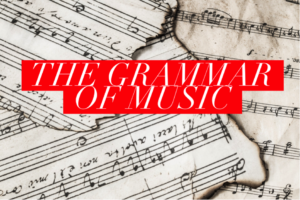
Who knew that music had its own written language and punctuation? Read on to find out more…
Music is steeped far back in history, and appears to have always featured, even in a very primitive form. However, how do researchers know this? Well, it’s largely to do with the discovery of paintings and writings that have been left behind, indicating that from very early periods, music has been written down in one form or another.
The evolution of how music has been written and how its own language has been created has significant developments throughout history, dating back to Ancient Greece in 600 BC, to our more modern musical language with horizontal lines, clefs, semitones and microtones.
A history of musical language…
600 BC
In Ancient Greece, Pythagoras used mathematics to understand the musical scale. He discovered that two notes which make an interval of an octave always have a ratio of 2:1. A perfect fifth is made with the ratio of 3:2, and a perfect 4th is 2:3. Combinations of these intervals then create the other notes which make up the major scale.
100 AD
Again, in Ancient Greece, the first known example of a complete notated song with lyrics and music was found written on a tombstone. Known as the Seikilos Epitaph, the Ancient Greeks labelled the notes of Pythagorus’ scale with letters from the Greek alphabet.
500 AD
Roman philosopher Boethius used the Ancient Greek texts regarding music notation, and also used letters to name the notes of the scale. Writing in Latin, Boethius used the letters from ‘a’ to ‘o’ (Roman letters) to represent the scale from the lowest note that a male voice can sing to the highest.
600 AD
Across Europe, monks sing religious songs known as ‘Plainchant’. Memorising plainsongs by heart, monks created a system called ‘neumes’ to sort and categorise songs, using flecks and squiggles written above the words to a song, to tell the singers when the pitch is rising or falling.
1000 AD
In Italy, Benedictine monk Guido d’Arezzo began to draw a single red line on a page to replace neumes and represent a fixed pitch. Guido developed this system, adding extra lines and colours, creating the four-line stave. This period also sees the replacement of the squiggly neumes with square-shaped note symbols.
1100 AD
Many manuscripts have been found showing the use of a five-line stave.
1100 AD
Across Europe, written notes are developed to represent both pitch and rhythm. Note names were also created: ‘maxima’ for the longest duration of a note, followed by ‘longa’, then ‘breve’ (brief) and ‘semibreve’ representing the smallest length of note – the ‘minima’.
1600 AD
During the 17th Century in Europe, notes are written in an oval shape and smaller notes have been introduced – ‘crotchet’ (quarter note) and ‘quaver’ (eighth note). This era also marks the introduction of bar lines to write and record music.
The bar line represents units of time and divides music into measures of notes and rests. Each measure has a specific number of beats — most commonly, four beats, which creates a pattern to organise the writing and reading of music for both the composer and the performer.
1700 AD
As Baroque music evolves into Classical music, notation begins to incorporate symbols such as staccato and slurs, and letters for dynamics (p and f). The number of clefs is also reduced to the three/four that we continue to use in modern scores – the G clef (treble), the F clef (bass) and the C clefs (alto and tenor).
20th Century and beyond
Musical notation continues to evolve, such as the introduction of microtones, and will no doubt continue as with all written languages. It provides the foundation on which to be creative and is only limited by the composer’s creativity and imagination. Play on!
Harmeet April 3rd, 2018
Posted In: Uncategorised